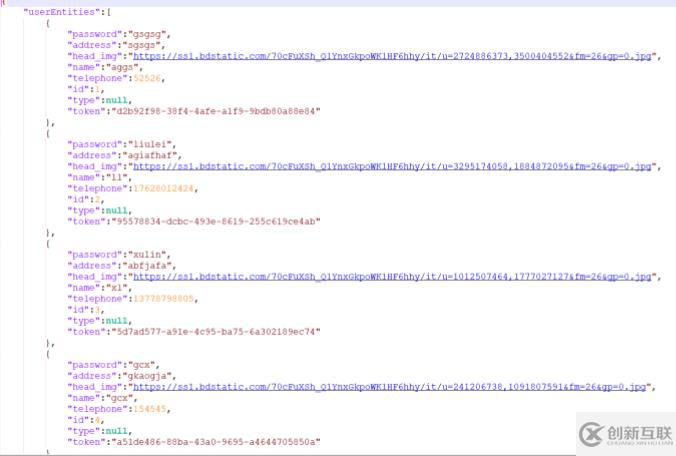java如何利用json文件來實現(xiàn)數(shù)據(jù)庫數(shù)據(jù)的導入導出
這篇文章將為大家詳細講解有關java如何利用json文件來實現(xiàn)數(shù)據(jù)庫數(shù)據(jù)的導入導出,小編覺得挺實用的,因此分享給大家做個參考,希望大家閱讀完這篇文章后可以有所收獲。
成都創(chuàng)新互聯(lián)是一家集網(wǎng)站建設,塔城企業(yè)網(wǎng)站建設,塔城品牌網(wǎng)站建設,網(wǎng)站定制,塔城網(wǎng)站建設報價,網(wǎng)絡營銷,網(wǎng)絡優(yōu)化,塔城網(wǎng)站推廣為一體的創(chuàng)新建站企業(yè),幫助傳統(tǒng)企業(yè)提升企業(yè)形象加強企業(yè)競爭力。可充分滿足這一群體相比中小企業(yè)更為豐富、高端、多元的互聯(lián)網(wǎng)需求。同時我們時刻保持專業(yè)、時尚、前沿,時刻以成就客戶成長自我,堅持不斷學習、思考、沉淀、凈化自己,讓我們?yōu)楦嗟钠髽I(yè)打造出實用型網(wǎng)站。
背景:
工作中我們可能會遇到需要將某個環(huán)境中的某些數(shù)據(jù)快速的移動到另一個環(huán)境的情況,此時我們就可以通過導入導出json文件的方式實現(xiàn)。
舉例:
我們將這個環(huán)境的數(shù)據(jù)庫中用戶信息導出為一份json格式文件,再直接將json文件復制到另一個環(huán)境導入到數(shù)據(jù)庫,這樣可以達到我們的目的。
下面我將使用springboot搭建用戶數(shù)據(jù)信息的導入導出案例,實現(xiàn)了單用戶和多用戶數(shù)據(jù)庫信息的導入導出功能。認真看完這篇文章,你一定能掌握導入導出json文件的核心
準備工作
需要maven依賴坐標:
<dependency>
<groupId>org.springframework.boot</groupId>
<artifactId>spring-boot-starter-web</artifactId>
</dependency>
<dependency>
<groupId>org.springframework.boot</groupId>
<artifactId>spring-boot-starter-actuator</artifactId>
</dependency>
<dependency>
<groupId>org.springframework.boot</groupId>
<artifactId>spring-boot-starter-thymeleaf</artifactId>
</dependency>
<dependency>
<groupId>org.projectlombok</groupId>
<artifactId>lombok</artifactId>
<optional>true</optional>
</dependency>
<dependency>
<groupId>org.mybatis.spring.boot</groupId>
<artifactId>mybatis-spring-boot-starter</artifactId>
<version>2.1.0</version>
</dependency>
<dependency>
<groupId>MySQL</groupId>
<artifactId>mysql-connector-java</artifactId>
<version>8.0.18</version>
</dependency>
<dependency>
<groupId>org.springframework.boot</groupId>
<artifactId>spring-boot-starter-jdbc</artifactId>
</dependency>
<dependency>
<groupId>com.alibaba</groupId>
<artifactId>fastjson</artifactId>
<version>1.2.29</version>
</dependency>
<dependency>
<groupId>org.codehaus.jackson</groupId>
<artifactId>jackson-mapper-asl</artifactId>
<version>1.9.13</version>
</dependency>數(shù)據(jù)庫中的用戶信息:
這些字段信息與Java中的UserEntity實體類一一對應

功能實現(xiàn)
準備好依賴和數(shù)據(jù)庫信息之后,開始搭建用戶導入導出具體框架:

導入導出單用戶、多用戶功能實現(xiàn) UserUtil
package com.leige.test.util;
import com.alibaba.fastjson.JSON;
import com.alibaba.fastjson.JSONObject;
import com.alibaba.fastjson.serializer.SerializerFeature;
import com.leige.test.entity.UserEntity;
import com.leige.test.entity.UserEntityList;
import com.leige.test.model.ResultModel;
import com.leige.test.service.UserService;
import org.apache.commons.io.FileUtils;
import org.codehaus.jackson.map.ObjectMapper;
import org.springframework.util.ObjectUtils;
import org.springframework.web.multipart.MultipartFile;
import javax.servlet.http.HttpServletResponse;
import java.io.*;
import java.net.URLEncoder;
import java.util.List;
import java.util.UUID;
public class UserUtil {
//導入用戶
public static ResultModel importUser(MultipartFile multipartFile, UserService userService) {
ResultModel resultModel = new ResultModel();
try {
// 獲取原始名字
String fileName = multipartFile.getOriginalFilename();
// 獲取后綴名
String suffixName = fileName.substring(fileName.lastIndexOf("."));
//先將.json文件轉為字符串類型
File file = new File("/"+ fileName);
//將MultipartFile類型轉換為File類型
FileUtils.copyInputStreamToFile(multipartFile.getInputStream(),file);
String jsonString = FileUtils.readFileToString(file, "UTF-8");
//如果是json或者txt文件
if (".json".equals(suffixName) || ".txt".equals(suffixName)) {
//再將json字符串轉為實體類
JSONObject jsonObject = JSONObject.parseObject(jsonString);
UserEntity userEntity = JSONObject.toJavaObject(jsonObject, UserEntity.class);
userEntity.setId(null);
userEntity.setToken(UUID.randomUUID().toString());
//調用創(chuàng)建用戶的接口
userService.addUser(userEntity);
} else {
resultModel.setStatusCode(0);
resultModel.setStatusMes("請上傳正確格式的.json或.txt文件!");
}
} catch (Exception e) {
e.printStackTrace();
}
return resultModel;
}
//批量導入用戶
public static ResultModel importUsers(MultipartFile multipartFile, UserService userService) {
ResultModel resultModel = new ResultModel();
try {
// 獲取原始名字
String fileName = multipartFile.getOriginalFilename();
// 獲取后綴名
String suffixName = fileName.substring(fileName.lastIndexOf("."));
//先將.json文件轉為字符串類型
File file = new File("/"+ fileName);
//將MultipartFile類型轉換為File類型
FileUtils.copyInputStreamToFile(multipartFile.getInputStream(),file);
String jsonString = FileUtils.readFileToString(file, "UTF-8");
//如果是json或者txt文件
if (".json".equals(suffixName) || ".txt".equals(suffixName)) {
//再將json字符串轉為實體類
JSONObject jsonObject = JSONObject.parseObject(jsonString);
UserEntityList userEntityList = JSONObject.toJavaObject(jsonObject, UserEntityList.class);
List<UserEntity> userEntities = userEntityList.getUserEntities();
for (UserEntity userEntity : userEntities) {
userEntity.setId(null);
userEntity.setToken(UUID.randomUUID().toString());
//調用創(chuàng)建用戶的接口
userService.addUser(userEntity);
}
} else {
resultModel.setStatusCode(0);
resultModel.setStatusMes("請上傳正確格式的.json或.txt文件!");
}
} catch (Exception e) {
e.printStackTrace();
}
return resultModel;
}
//導出某個用戶
public static ResultModel exportUser(HttpServletResponse response, UserEntity userEntity, String fileName){
ResultModel resultModel = new ResultModel();
ObjectMapper objectMapper = new ObjectMapper();
if (ObjectUtils.isEmpty(userEntity)){
resultModel.setStatusCode(0);
resultModel.setStatusMes("此用戶id沒有對應的用戶");
return resultModel;
}else {
try {
String jsonString = objectMapper.writeValueAsString(userEntity);
// 拼接文件完整路徑// 生成json格式文件
String fullPath = "/" + fileName;
// 保證創(chuàng)建一個新文件
File file = new File(fullPath);
if (!file.getParentFile().exists()) { // 如果父目錄不存在,創(chuàng)建父目錄
file.getParentFile().mkdirs();
}
if (file.exists()) { // 如果已存在,刪除舊文件
file.delete();
}
file.createNewFile();//創(chuàng)建新文件
//將字符串格式化為json格式
jsonString = jsonFormat(jsonString);
// 將格式化后的字符串寫入文件
Writer write = new OutputStreamWriter(new FileOutputStream(file), "UTF-8");
write.write(jsonString);
write.flush();
write.close();
FileInputStream fis = new FileInputStream(file);
// 設置相關格式
response.setContentType("application/force-download");
// 設置下載后的文件名以及header
response.setHeader("Content-Disposition", "attachment;filename="
.concat(String.valueOf(URLEncoder.encode(fileName, "UTF-8"))));
response.setCharacterEncoding("utf-8");
// 創(chuàng)建輸出對象
OutputStream os = response.getOutputStream();
// 常規(guī)操作
byte[] buf = new byte[1024];
int len = 0;
while((len = fis.read(buf)) != -1) {
os.write(buf, 0, len);
}
fis.close();
os.close(); //一定要記得關閉輸出流,不然會繼續(xù)寫入返回實體模型
return resultModel;
} catch (Exception e) {
resultModel.setStatusCode(0);
resultModel.setStatusMes(e.getMessage());
e.printStackTrace();
return resultModel;
}
}
}
//導出所有用戶
public static ResultModel exportAllUser(HttpServletResponse response, UserEntityList userEntityList, String fileName){
ResultModel resultModel = new ResultModel();
ObjectMapper objectMapper = new ObjectMapper();
if (ObjectUtils.isEmpty(userEntityList)){
resultModel.setStatusCode(0);
resultModel.setStatusMes("此用戶id沒有對應的用戶");
return resultModel;
}else {
try {
String jsonString = objectMapper.writeValueAsString(userEntityList);
// 拼接文件完整路徑// 生成json格式文件
String fullPath = "/" + fileName;
// 保證創(chuàng)建一個新文件
File file = new File(fullPath);
if (!file.getParentFile().exists()) { // 如果父目錄不存在,創(chuàng)建父目錄
file.getParentFile().mkdirs();
}
if (file.exists()) { // 如果已存在,刪除舊文件
file.delete();
}
file.createNewFile();//創(chuàng)建新文件
//將字符串格式化為json格式
jsonString = jsonFormat(jsonString);
// 將格式化后的字符串寫入文件
Writer write = new OutputStreamWriter(new FileOutputStream(file), "UTF-8");
write.write(jsonString);
write.flush();
write.close();
FileInputStream fis = new FileInputStream(file);
// 設置相關格式
response.setContentType("application/force-download");
// 設置下載后的文件名以及header
response.setHeader("Content-Disposition", "attachment;filename="
.concat(String.valueOf(URLEncoder.encode(fileName, "UTF-8"))));
response.setCharacterEncoding("utf-8");
// 創(chuàng)建輸出對象
OutputStream os = response.getOutputStream();
// 常規(guī)操作
byte[] buf = new byte[1024];
int len = 0;
while((len = fis.read(buf)) != -1) {
os.write(buf, 0, len);
}
fis.close();
os.close(); //一定要記得關閉輸出流,不然會繼續(xù)寫入返回實體模型
return resultModel;
} catch (Exception e) {
resultModel.setStatusCode(0);
resultModel.setStatusMes(e.getMessage());
e.printStackTrace();
return resultModel;
}
}
}
//將字符串格式化為json格式的字符串
public static String jsonFormat(String jsonString) {
JSONObject object= JSONObject.parseObject(jsonString);
jsonString = JSON.toJSONString(object, SerializerFeature.PrettyFormat, SerializerFeature.WriteMapNullValue, SerializerFeature.WriteDateUseDateFormat);
return jsonString;
}
}1、啟動項目,瀏覽器輸入訪問 http://localhost:8888/export/users 導出所有已有用戶json文件

2、打開json文件查看格式是否正確

3、瀏覽器輸入訪問 http://localhost:8888/ 批量導入用戶
導入 users.json 文件

輸入地址,點擊提交

查看數(shù)據(jù)庫,發(fā)現(xiàn)增加的兩條測試用戶1,2成功!

導入導出單個用戶這里就不測試了,更加簡單,其他的關于springboot配置文件和實體類對應數(shù)據(jù)庫信息也不詳細說明了。
關于java如何利用json文件來實現(xiàn)數(shù)據(jù)庫數(shù)據(jù)的導入導出就分享到這里了,希望以上內容可以對大家有一定的幫助,可以學到更多知識。如果覺得文章不錯,可以把它分享出去讓更多的人看到。
當前標題:java如何利用json文件來實現(xiàn)數(shù)據(jù)庫數(shù)據(jù)的導入導出
網(wǎng)頁鏈接:http://m.newbst.com/article28/ijsecp.html
成都網(wǎng)站建設公司_創(chuàng)新互聯(lián),為您提供網(wǎng)站建設、軟件開發(fā)、小程序開發(fā)、Google、虛擬主機、品牌網(wǎng)站制作
聲明:本網(wǎng)站發(fā)布的內容(圖片、視頻和文字)以用戶投稿、用戶轉載內容為主,如果涉及侵權請盡快告知,我們將會在第一時間刪除。文章觀點不代表本網(wǎng)站立場,如需處理請聯(lián)系客服。電話:028-86922220;郵箱:631063699@qq.com。內容未經(jīng)允許不得轉載,或轉載時需注明來源: 創(chuàng)新互聯(lián)

- 金融網(wǎng)站建設競爭力,品牌網(wǎng)站設計新趨勢 2014-06-08
- 品牌網(wǎng)站設計制作的簡單步驟 2022-12-03
- 品牌網(wǎng)站設計制作-是企業(yè)對外的名片和形象 2020-11-28
- 企業(yè)品牌網(wǎng)站設計思路介紹 2023-01-29
- 怎樣做深圳品牌網(wǎng)站設計才有效果 2021-10-18
- 用戶體驗其實就這么簡單! 2022-06-07
- 深圳品牌網(wǎng)站設計公司 2014-05-13
- 吳江高端網(wǎng)站建設制作品牌網(wǎng)站設計如何布局 2020-11-23
- 品牌網(wǎng)站設計都需要一個“新聞工具包” 2023-03-02
- 4個消費電子產(chǎn)品的品牌網(wǎng)站設計 2021-09-28
- 品牌網(wǎng)站設計的流程有哪些 2023-02-13
- 品牌網(wǎng)站設計的意義是什么,如何起到這種效果? 2022-09-30